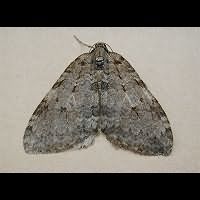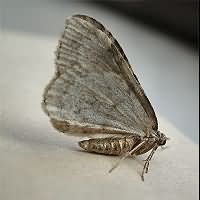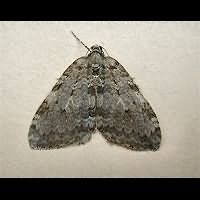Autumnal Moth (Epirrita autumnata)
A black and grey geometer which can hardly be told apart from similar species by the naked eye. The November Moth, the Pale November Moth and the Autumnal Moth can only be identified for sure by examining the genitals. To be able to do this, the animals have to be killed and that is something we don't do. Besides: both the November Moth and the Pale November Moth are rather variable. And despite the names, all species appear in October rather than November. Judging by shape, the veins, which are not strongly accentuated, and the place of the black dot, we think the animals in the pictures could be Autumnal Moths, but we are not sure at all! These species all have about the same wingspan: 38 to 44 mm.
The eggs are being laid in October or November on twigs or in openings in the bark of trees. They only hatch by the end of April or in May next year. The caterpillar of the Autumnal Moth usually differs from the larva of the November Moth. It too is green, but so is the underside, which is white in the November Moth's. Often the caterpillar is richly marked: in the middle of the back a black dorsal line and besides a yellow one often with a connecting black one. On the sides about half way a white line, which also may be reddish and yellow. The head is green and unmarked. Fullgrown caterpillars will reach a length of some 25 mm. Alas, regularly more difficult caterpillars pop up: they are plain green and do not show many markings. These do look like unmarked caterpillars of the other Eipritta species a lot. In June or July the caterpillar of the Autumnal Moth descends down the tree and goes underground to pupate in a cocoon. The larvae accept lots of foodplants: trees, like Birch, and small plants, like heather and bilberry. In Northern Europe and Northern America found on conifers as well.
The Autumnal Moth has only one generation a year, which is on the wing in October and the beginning of November. Usually on the wing for a short period only: about 4 weeks. Does not fly in dusk a lot and is thus rarely seen on Ivy. Readily comes to light, every now and then in great numbers. Like other Epiritta species often sits like a butterfly. It is a woodland species, but it doesn't like dense forests. In Britain a common species all over. Also common on the continent, but a local species southwards. Abundant in the vast birch forests in Northern Europe (including Scotland). In Northern America wide spread in the Northeast, especially common in conifer woodlands.
In Northern America this species is known as the Green Velvet Looper.
A black and grey geometer which can hardly be told apart from similar species by the naked eye. The November Moth, the Pale November Moth and the Autumnal Moth can only be identified for sure by examining the genitals. To be able to do this, the animals have to be killed and that is something we don't do. Besides: both the November Moth and the Pale November Moth are rather variable. And despite the names, all species appear in October rather than November. Judging by shape, the veins, which are not strongly accentuated, and the place of the black dot, we think the animals in the pictures could be Autumnal Moths, but we are not sure at all! These species all have about the same wingspan: 38 to 44 mm.
The eggs are being laid in October or November on twigs or in openings in the bark of trees. They only hatch by the end of April or in May next year. The caterpillar of the Autumnal Moth usually differs from the larva of the November Moth. It too is green, but so is the underside, which is white in the November Moth's. Often the caterpillar is richly marked: in the middle of the back a black dorsal line and besides a yellow one often with a connecting black one. On the sides about half way a white line, which also may be reddish and yellow. The head is green and unmarked. Fullgrown caterpillars will reach a length of some 25 mm. Alas, regularly more difficult caterpillars pop up: they are plain green and do not show many markings. These do look like unmarked caterpillars of the other Eipritta species a lot. In June or July the caterpillar of the Autumnal Moth descends down the tree and goes underground to pupate in a cocoon. The larvae accept lots of foodplants: trees, like Birch, and small plants, like heather and bilberry. In Northern Europe and Northern America found on conifers as well.
The Autumnal Moth has only one generation a year, which is on the wing in October and the beginning of November. Usually on the wing for a short period only: about 4 weeks. Does not fly in dusk a lot and is thus rarely seen on Ivy. Readily comes to light, every now and then in great numbers. Like other Epiritta species often sits like a butterfly. It is a woodland species, but it doesn't like dense forests. In Britain a common species all over. Also common on the continent, but a local species southwards. Abundant in the vast birch forests in Northern Europe (including Scotland). In Northern America wide spread in the Northeast, especially common in conifer woodlands.
In Northern America this species is known as the Green Velvet Looper.







